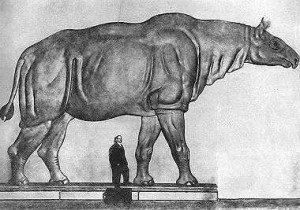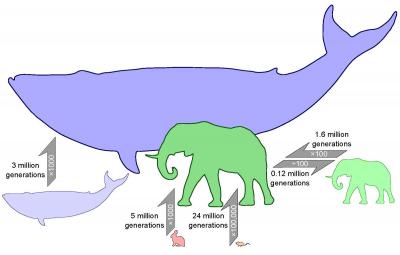
About 65 million years ago, our nearest ancestor was probably something small, scuffling and more rat-like than you may be comfortable with. But after a giant asteroid wiped out practically all of the dinosaurs (excepting those which became birds) mammals were suddenly free to take up new lifestyles. 30 million years later, they had produced Baluchitherium, a rhinoceros-like creature twice the size of a modern elephant. Just how fast can an evolutionary group increase in size, and how fast could they do the reverse? Jessica Theodor has an answer. She’s an associate professor in the Department of Biological Sciences at the University of Calgary, and one of about 20 authors on a major paper published this week in Proceedings of the National Academy of Sciences.
Measuring evolutionary change is not totally new. Biologists even have a unit for it: the haldane, named after J.B.S. Haldane, one of the founders of population genetics (and a wonderfully colourful character to boot; anything written about him is well worth reading.) But according to Theodor, most previous measurements have been performed single lineages, over relatively modest timescales. This is more likely to capture microevolution, a measure of variation within species, like the differences between Chihuahuas and Great Danes. Theodor and her colleagues were interested in macroevolution, change above the species level. “It’s kind of like the relationship of weather to climate,” she says. “Those daily wiggles are the noise: the bigger pattern is only visible when you walk far away and squint.”

To see the bigger pattern, the group defined a measurement called the clade maximum rate (CMR). This is the rate of change of an extreme trait, for example, the largest animal within a clade. (A clade is a group of closely related animals sharing a common ancestor.) Theodor notes that the leader for a particular clade may change over a given period of time. “The group I work on is even-toed hoofed mammals, which includes cows, pigs, sheep, goats and camels. At one point camels were actually the biggest, but today hippos are,” she says.
The group measured the CMR of 28 mammal orders over the last 70 million years. Because we have a large number of living mammal groups to compare with fossils, the group was able to normalize their measurements to take account of generation time, i.e. the fact that large animals mature more slowly and have longer gestation periods than smaller ones. Looking at terrestrial mammals as a whole, the results show that a 100-fold increase in body size would take a minimum of 1.6 million generations, a 1000-fold increase 5.1 million, and a 5000-fold increase 10 million.
Outside of this maximum overall rate, some orders are faster than others. Odd-toed ungulates, which include rhinos and horses, grew faster than most, no surprise given that they produced the truly enormous Baluchtherium. Our own group, primates, has remained relatively small since the Cretaceous. And then there are whales. Although cetaceans only emerged in the last 31 million years, the fact that they live in water and thus don’t have to support their own weight has allowed them to positively balloon in size. Whales completed a 5000-fold size increase in just 5 million generation, half the maximum rate of terrestrial mammals. Cheaters.
The group also looked at the rate lineages can shrink in size. A good example of this is insular dwarfism, where large animals living on small islands tend to evolve smaller forms in order to make more efficient use of scare resources. Looking at examples like pygmy elephants, they found that the rate of getting smaller is 10 times faster than the maximum rate of growing larger. “If you’re going to evolve a larger size, there are a lot of structural constraints: you need more skeleton and muscle to move that skeleton, more infrastructure,” says Theodor. “But to be smaller, you just have to stop growing early. If you look at the pygmy elephants for example, their structures are overbuilt for their size. They look like big elephants shrunk small, instead of lightly built smaller animals.”
For their next project, Theodor expects the team will explore the relationship between dietary strategies and body size evolution. Her hunch is that animals that make a living by fermenting large amounts of nutrient-poor food like grass have a stronger imperative to get big than ones that eat nutrient-rich food like fruit. If she’s right, it would explain why monkeys, humans, and bats have remained relatively small, while fermenters like cows, elephants and deer have grown large; they need a bigger gut to house the bacteria that digest their food.
Besides providing important metrics to quantify evolution and explanations of why the world is the way it is, studies like this allow us to speculate on the future. 10 million generations from now, the Earth may be populated with giant versions of animals we regard as small and scuffling, but which are merely biding their time until the Earth’s dominant species – us – disappears.
2 Comments
Very informative. Amazing -overbuilt dwarf elephants, are they extinct?
Good question. Elephants that exhibited insular dwarfism were once widespread, but most are sadly extinct.
http://en.wikipedia.org/wiki/Dwarf_elephant
Today, the only island-dwelling elephants are in Borneo. It’s debated whether they are descendants of the native dwarf species, or of an introduced strain of Indian elephant.
http://en.wikipedia.org/wiki/Borneo_elephant